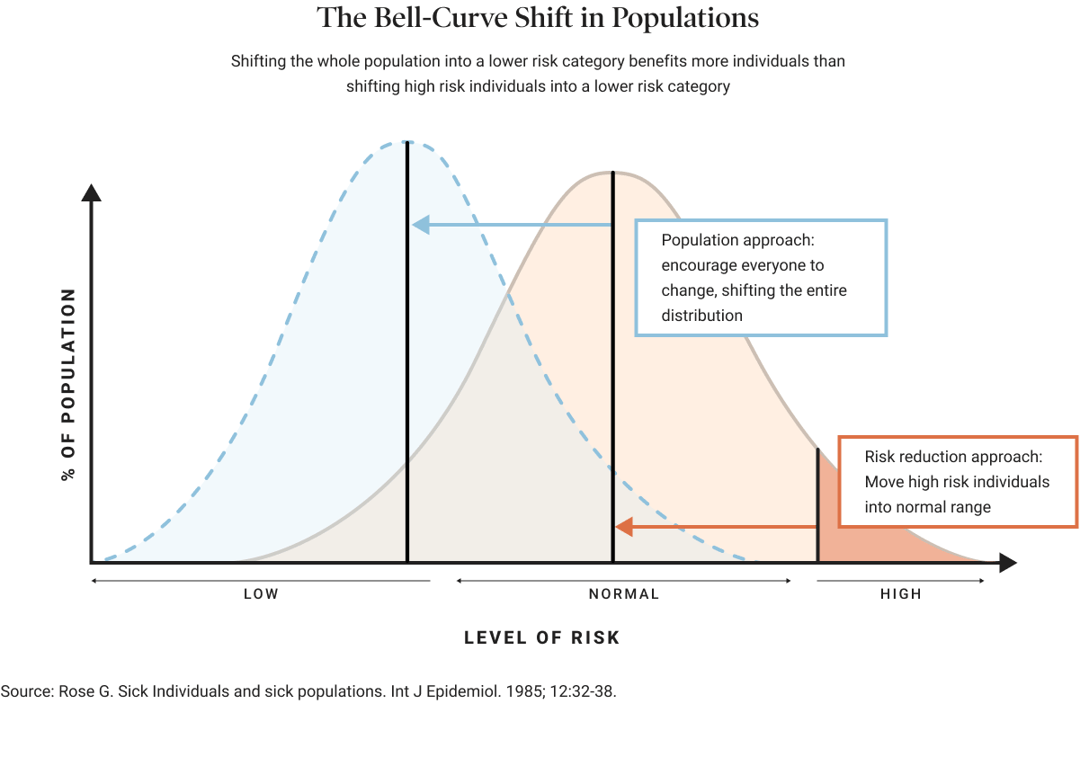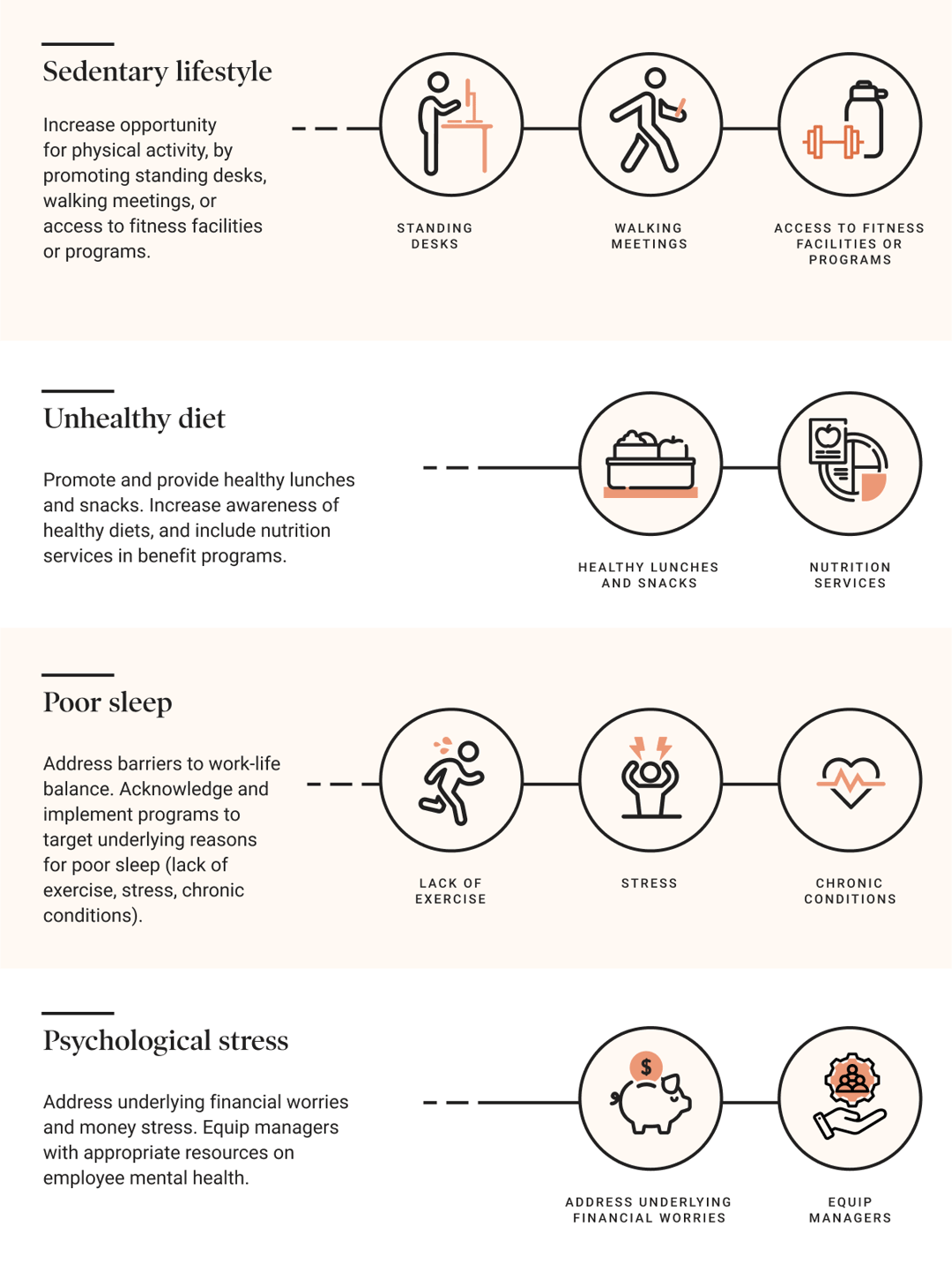With 1 in 4 Canadians struggling with a mental illness, mental health is a leading cause of disability in Canada. According to a recent survey, over 25% of Canadians report that work is their main source of stress, and 35% report being burned out.
In response, HR leaders across Canada are working to create healthier and psychologically safe workplaces. Employers aim to identify risk factors, and intervene before an employee develops a mental health diagnosis or goes on disability leave. But, choosing an effective health promotion and wellness program can be confusing.
Wellness lacks a universal definition, and programs may have murky objectives. Changing wellness headlines and trends create a fuzzy landscape where everything and anything falls under the umbrella of “wellness”. And some programs may risk incentivizing the wrong behaviours altogether.
For example, fitness applications that focus on granular metrics, like weight and calories, may negatively impact mental health and increase the risk of disordered eating.
As a result, employers can be left unsure about how to implement effective wellness programs that create healthier employees today, build resilience, and may work to prevent future mental health cases.
What’s the science behind wellness?
Organizations can learn about the science of prevention in order to distinguish wellness “fluff” from evidence-based initiatives that actually have a positive health impact on all employees.
What is prevention?
Just because employees aren’t sick, it doesn't mean they shouldn’t take action to preserve or improve their health and prevent future illness, disease, or disability. Both employees and employers have a responsibility to build an environment that promotes healthy living.
Let’s borrow a few prevention examples from public health departments. These strategies work so quietly in the background that you might not notice how they protect and preserve health every day.
-
Many cities fortify their water supply with fluoride to prevent cavities.
-
Cow's milk has been fortified with vitamin D for over 50 years to prevent the spread of rickets in Canada.
-
Routine immunizations greatly reduce illness, prevent diseases like measles, and save lives.
Could you imagine if our healthcare system was built to only treat disease, disability, and illness instead of implementing prevention strategies? Without these strategies, healthcare costs would skyrocket and resources of the healthcare system would be strained with preventable cases.
Unfortunately, traditional support, like employee assistance programs (EAP) and health & medical benefits, are not designed to prevent future illness. Instead, they only treat individual cases. While support such as EAPs are crucial in times of crisis, their reactive approach does not address the larger picture.
No matter the time, energy, and money invested in the small number of people experiencing (or at high risk of experiencing) active illness or disease, it will never address where the majority of the disease burden comes from: generally healthy individuals.
The key to prevention is to engage all employees, regardless of their health status, in adopting healthy behaviours. Wellness programs should be personalized, and extend beyond marathon runners or those actively seeking medical care. Rather, they should include everyday employees who would benefit from meaningful change.
This approach enables employers to shift from a reactive approach to a population prevention strategy, where more employees improve their health and the overall risk of developing future disease, illness, or disability decreases.
The graph below shows how prevention (wellness programs that encourage organizations and individuals to make small, incremental changes) has a greater impact on workforce health than support for higher risk groups alone (EAPs or clinical approach).

How can employers implement prevention in the workplace?
As employees spend the majority of their weekdays at work, their work environment may directly impact their ability to make healthy lifestyle choices or sustain healthy behaviours, resulting in:
-
Sedentary lifestyles
-
Poor diet
-
Poor sleep quality
-
Psychological stress
While work can contribute to an unhealthy lifestyle, it also presents an opportunity for employers to address these risk factors proactively.

These initiatives can be delivered by mobile applications, in-person sessions, awareness booths, and even in employee advocacy or resource groups. Healthy behaviour change at scale is most effective when prevention initiatives are built into workplace culture. Instead of adopting episodic benefits like EAPs, promoting healthy lifestyles as the norm nudges employees to adopt desired health-promoting behaviours. (More on nudge theory here.)
Building healthy lifestyle strategies also starts to flex employees’ mental health and fitness muscle, which is a business skill. Employees with solid healthy lifestyle habits, including regular physical activity, a balanced healthy diet, and stress management techniques, are equipped to perform better on the job.
These individuals are more capable of overcoming adversity and set-backs, adapting to new challenges, and even increasing their sense of self-efficacy – a belief in their capacity to execute behaviours necessary to perform.
This translates into greater productivity and reductions in absenteeism. For example, employees’ work performance can be improved by 4% to 15% through participation in regular physical activity.
What sets Dialogue’s Wellness program apart?
Backed by behavioural scientists and validated by our clinical team, Dialogue’s Wellness program tackles real workforce health challenges. Focused on prevention, the program is:
-
Built to engage all your employees
-
Drives healthy habit-forming behaviours
-
Enables employers to be proactive instead of reactive
-
Allows employees to seamlessly transition to clinical services
Wellness deliver measurable outcomes for your team, empowering members to take wellness into their own hands through fitness challenges, healthy habit collections, and a variety of self-serve content.
Learn how you can benefit from Wellness to reduce absenteeism and health-related costs, while reinforcing a culture of well-being.




 Canada (EN)
Canada (EN)
 Global (EN)
Global (EN)








